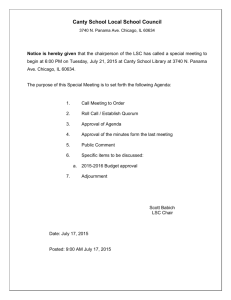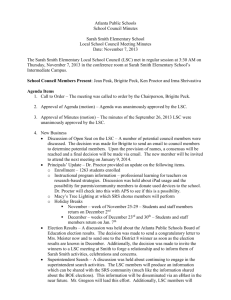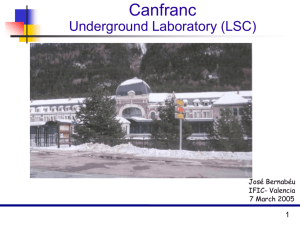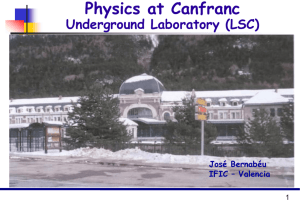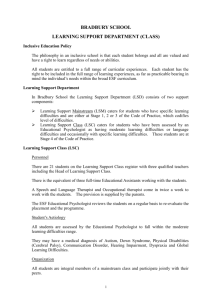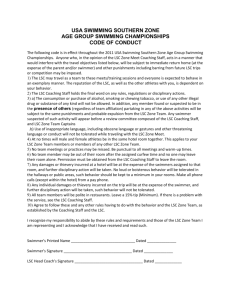Report LSC infrastructure
advertisement
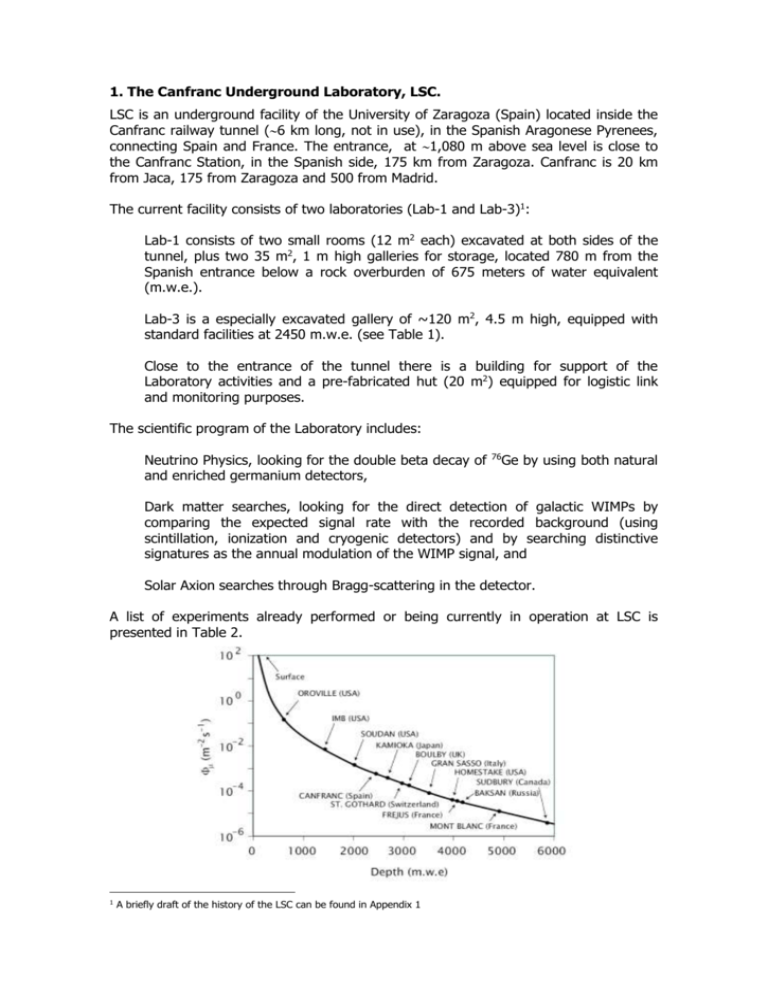
1. The Canfranc Underground Laboratory, LSC. LSC is an underground facility of the University of Zaragoza (Spain) located inside the Canfranc railway tunnel (6 km long, not in use), in the Spanish Aragonese Pyrenees, connecting Spain and France. The entrance, at 1,080 m above sea level is close to the Canfranc Station, in the Spanish side, 175 km from Zaragoza. Canfranc is 20 km from Jaca, 175 from Zaragoza and 500 from Madrid. The current facility consists of two laboratories (Lab-1 and Lab-3)1: Lab-1 consists of two small rooms (12 m2 each) excavated at both sides of the tunnel, plus two 35 m2, 1 m high galleries for storage, located 780 m from the Spanish entrance below a rock overburden of 675 meters of water equivalent (m.w.e.). Lab-3 is a especially excavated gallery of ~120 m2, 4.5 m high, equipped with standard facilities at 2450 m.w.e. (see Table 1). Close to the entrance of the tunnel there is a building for support of the Laboratory activities and a pre-fabricated hut (20 m2) equipped for logistic link and monitoring purposes. The scientific program of the Laboratory includes: Neutrino Physics, looking for the double beta decay of and enriched germanium detectors, 76 Ge by using both natural Dark matter searches, looking for the direct detection of galactic WIMPs by comparing the expected signal rate with the recorded background (using scintillation, ionization and cryogenic detectors) and by searching distinctive signatures as the annual modulation of the WIMP signal, and Solar Axion searches through Bragg-scattering in the detector. A list of experiments already performed or being currently in operation at LSC is presented in Table 2. 1 A briefly draft of the history of the LSC can be found in Appendix 1 In the last fifteen years more than fifty scientists from twelve institutions from eight countries (Argentina, Armenia, France, Italy, Portugal, Russia, Spain and USA) have participated in the LSC Scientific Program. The research infrastructures built in the tunnel, the investments on experimental equipment, the running costs and other scientific activities of the LSC are funded by the Spanish National Programs of High Energy Physics, and of Particle Physics and Accelerators of the Ministry of Science and Technology. Other funding contributions come from the University of Zaragoza, the TMR Program of the European Union and the Regional Government of Aragon. Occasional contributions are those of the DOE (USA) and NSF (USA), the INFN (Italy) and CNRS (France) and INR and ITEP (Russia). Since 2004, the European Community is contributing to the development of the Laboratory through the ILIAS project within the 6th framework programme. The Canfranc Underground Laboratory is being significantly enlarged by means of grants from the Spanish Ministry of Science and Technology and the Aragonese Autonomous Government (DGA), with two new experimental halls 50 m from the old facility at the same depth of 2450 m.w.e.: the main one (45x15x11 m3) oriented towards CERN to allow the possibility to use neutrino beams coming from there and an ultra low background facility (15x10x8 m3). An access corridor housing offices, clean room and workshops for a total of about 1,000 m2 completes the facility which should be finished next summer 2005. The first call for proposals for dark matter detection, next generation Double Beta Decay experiments and medium-size neutrino experiments will be announced soon. 2. Facilities at LSC At LSC there is an underground facility for ultra-low background (ULBF) measurements consisting of two non-commercial HPGe detectors, shielding and electronics. Also five (10 kg. each) NaI detectors will be available, plus electronics and shielding. The ULBF presently used in LSC is being upgraded and enlarged with two new ultralow background HPGe detectors and NaI for radio-purity measurements. Equipment for neutron and radon measurements and control will also be installed. In the new LSC (enlarged) facility, a set of clean rooms of class 100 to 1000 (totalling ~80-100 m2) will be installed. In these and in an adjacent zone, an electroplating facility to fabricate high-purity copper detector components will be installed (both for cryo and non-cryogenic purposes). A mechanical workshop to machine the electroformed pieces will be established nearby. The copper components of low background detectors will be electroformed from an ultra-pure CuSO4 solution onto polished stainless-steel mandrels. A special area in the mechanical workshop sector of the new LSC will be dedicated to the making of lead shielding. Archaeological lead (and other old lead) will be melted (two-three times for cleaning up of impurities) in a pure inert gas atmosphere in a special tungstate crucible. The resulting pure lead will be melted again into bricks (or other forms as required) and machined accordingly, following the technique used successfully by the Zaragoza group for more than ten years. The underground facility for electroforming copper and production of pure lead bricks will be available by the end of 2005. A feasibility study for the installation at the new LSC of a prototype underground facility for growth of detector crystals (this being the ultimate strategy for avoiding the cosmogenic activation of material components) is underway. The LSC Laboratory headquarters located near the tunnel entrance will offer standard technical support and offices, computing facilities, library and conference rooms to users. Support for operating the low background facilities (detectors, shielding …) will also be offered. Two very convenient hotels are located 50 and 100 m from the tunnel entrance. In Jaca (20 km from the tunnel), the University of Zaragoza has two University Residences (120 and 18 places) with guest rooms available for the members of the LSC experiments, as well as with other facilities (offices, rooms, conference rooms, …). A network of personal computers linked to the computer centre of the University of Zaragoza will also be available at LSC. Appendix 1. Short history of the LSC In the mid eighties, there was no infrastructure in the Canfranc railway tunnel except for two small halls (about 12 m2 each plus two 35 m2, 1 m high galleries) located 780 m from the Spanish entrance below a rock overburden of 675 meters of water equivalent (m.w.e.). In 1986, preliminary measurements of radioactive contamination and cosmic radiation were carried out with a mobile platform along the railway; conditioning works started shortly after (cleaning, electrical power installation, telephone, humidity and temperature control, and ventilation) and the two halls became what we now call Lab1. By 1988, the LSC consisted of the two small halls plus a prefabricated cabin, especially reinforced, of about 15 m2 and installed over the railway next to the two halls. In August 1988, as a result of a collaboration with the University of South Carolina (USC) and the Pacific Northwest National Laboratory (PNNL), the first ultra-low background detector came to Canfranc: a germanium hyperpure detector. With this detector preliminary measurements of materials (lead, copper, polyethylene, etc.) were carried out and fifteen months later (November 1989) the first experiment started in the Canfranc Underground Laboratory, a multi-detector system with 14 NaI scintillators and the germanium detector looking for the double beta decay of 76Ge. Since then, many other experiments have been operating in the Canfranc Underground Laboratory, which has undergone important modifications and improvements. In 1991 a new prefabricated cabin (about 27 m2) was added to the one already in operation and they were both moved to a new location (1,200 m from the Spanish entrance below an overburden of 1,380 m.w.e.). In this location and with the convenient conditioning of both cabins (electrical power installation, telephone, ventilation), they became Lab-2. In 1994, taking advantage of the excavation works for the new Somport road tunnel, a new experimental hall, 118 m2, at 2,520 m from the Spanish entrance and below an overburden of 2,450 m.w.e. was excavated. It was named Lab-3 (or main Lab), and has been in operation since the beginning of 1995. This new hall, much larger and deeper underground, has provided for a quantitative and qualitative progress in the research activities of the group; it allowed to start new experiments and to reach a clear improvement in the radioactive backgrounds. With the setting-up of this new hall, Lab-2 was dismounted. The small cabin was installed inside Lab-3 and the large one outside the tunnel for remote control of the experiments and communications. Lab-1 is used now only to store detectors and other materials (which are so kept shielded from the cosmic radiation). REFERENCES 1 2 3 4 5 6 7 8 9 10 11 12 13 14 A. Morales et al., Il Nuovo Cimento 104A , 1581 (1991) C. Sáenz et al., Phys. Rev. D50, 1170 (1994). E. García et al., Phys. Rev. D51, 1458 (1995). M.L. Sarsa et al., Phys. Rev. D56, 1856 (1997). A. Morales et al., Astrop. Phys. 16, 325 (2002) and references therein. C. E. Aalseth et al., Phys. Rev. D65, 092007 (2002). A. Morales et al., Phys. Lett. B532, 8 (2002). A. Morales et al., Phys. Lett. B489, 268 (2000). S. Cebrián et al., Astrop. Phys. 15, 79 (2001). S. Cebrián et al., Astrop. Phys. 21, 23 (2004). S. Cebrián et al., Phys. Lett. B563, 48 (2003). S. Cebrián et al., Phys.Lett. B556, 14 (2003). S. Cebrián et al., Nucl. Phys. (Proc. Suppl.) B114, 111 (2003). M. Martínez et al., Proceedigs of the 5th International Workshop on the Identification of Dark Matter (World Scientific) 15 I. G. Irastorza et al., Proceedigs of the 4th International Workshop on the Identification of Dark Matter, York, (World Scientific), p. 308.

